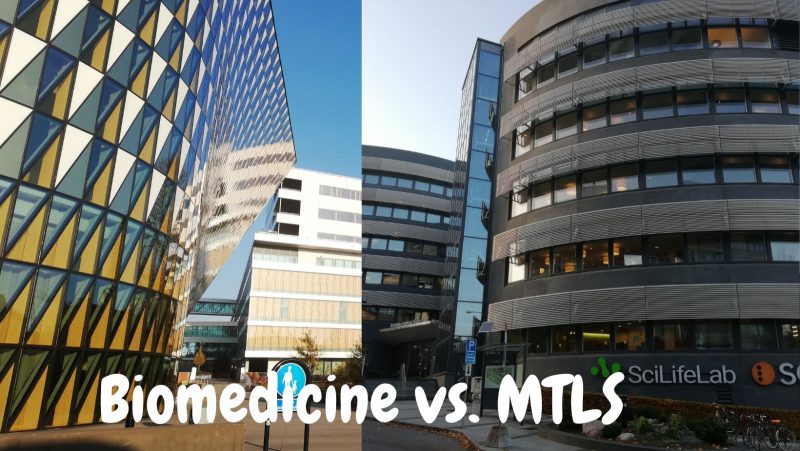
Biomedicine vs MTLS – Part 2
Welcome to Part 2 of this blog comparing the Biomedicine (MSc) and Molecular Techniques in Life Sciences programmes! Hopefully Part 1 solved some of your doubts.
To summarize, I would say the highlights of my programme in Biomedicine are theoretical knowledge of the most important topics in the biomedical field, the opportunity to obtain a lot of hands-on experience through 3 research projects, and learning from the great researchers at KI. That’s why I chose this Master’s. I might be a bit biased, but I believe it is an amazing programme!
On the other hand, Francisca chose Molecular Techniques in Life Science because of the free access to researchers at all three Stockholm universities, the collaborative nature of the team work involved throughout the degree, and finally because she also wanted to deepen her skills in computer science applications in the life sciences.
Part 2 will further help you choose between the two. Once again, these are just our personal thoughts and understanding of our programmes. You can find the official information on the Karolinska Institutet website for Biomedicine (MSc) and Molecular Techniques in Life Science.
Support
| Biomedicine | Molecular Techniques in Life Science |
| 40-45 people on average per class cohort Classes get smaller in elective track Teaching assistant support in one or two courses For research projects, course coordinators are open to help you find a project if you’re struggling to do so. Academic resources and counselling support at KI Steering committee and student union representatives provide feedback about courses | 30 people on average per class cohort Course coordinators know you by name for most courses because classes are small Extensive teaching assistant support in most programming courses Academic resources and counselling support at all three universities Steering committee and student union representatives provide feedback about courses |
Research Opportunities
| Biomedicine | Molecular Techniques in Life Science |
| 2 research project courses in the curriculum (mandatory) Thesis must be done in a different research group from other research courses The thesis project can be done at KI, other Swedish universities, industry, or abroad. You must find research opportunities by contacting PIs/labs directly Most of the opportunities are wet lab and in academia environment Some students find summer projects by contacting researchers. | 1 research project course (optional) 1 thesis project – can be done at KI, SU, SciLifeLab, industry, abroad, company Some research opportunities are paid at SciLifeLab, Biomedicum, SU Some PIs send new research position postings to our programme directly. Otherwise, you find your own lab group Also have the summer SciLifeLab fellowship that’s exclusive to our programme – get paid to do research for 8 weeks at SciLifeLab |
Network
| Biomedicine | Molecular Techniques in Life Science |
| Access to researchers at KI and international principal investigators through course lectures Mingle within research community at KI once you join a research group Biomedicine Mentorship Programme (first-year Master students in Biomedicine receive guidance from PhD students affiliated with KI) Access to clubs and associations at KI No established alumni association | Access to researchers at all 3 universities, SciLifeLab community Teaching assistant paid opportunities at KI and SU PhD and post-doc mentorship program for current students Access to clubs and associations at KI, SU, and KTH MTLS Alumni Network initiative – access to alumni, private LinkedIn group, Alumni Speaker Day and MTLS Career Fair events |
Career paths post-graduation
| Biomedicine | Molecular Techniques in Life Science |
| Research assistant at KI or SciLifeLab PhD track Genetic counsellor Mostly academia jobs but it’s also possible to go into industry | Research assistant at SciLifeLab Academic PhD or industrial PhD tracks Bioinformatician Data analyst R&D at pharma companies, e.g. AstraZeneca, Novo Nordisk Research associate at biotech companies, e.g. 10x Genomics Life Science industry consultant |
To conclude, we hope this blog has been helpful, and that the similarities and differences between these two programmes are now a bit clearer!
Feel free to ask us any other questions you may have in the comments below or by email. Once again, these blogs are not exclusively representative of what these programs are about, they are just from our point-of-view.
Best of luck with your applications! 🙂
Alessandra - Biomedicine (MSc)
Hi everybody! My name is Alessandra, but I usually go by my nickname, Kyomi. My role in the digital ambassador team is being the new Biomedicine (MSc) blogger. I was born and raised in Peru, but I moved to the United States for my undergraduate studies. After graduation, I worked for 2 years in a neuroscience lab. Now, I have moved to Sweden to be a student at Karolinska Institutet!

1 comments